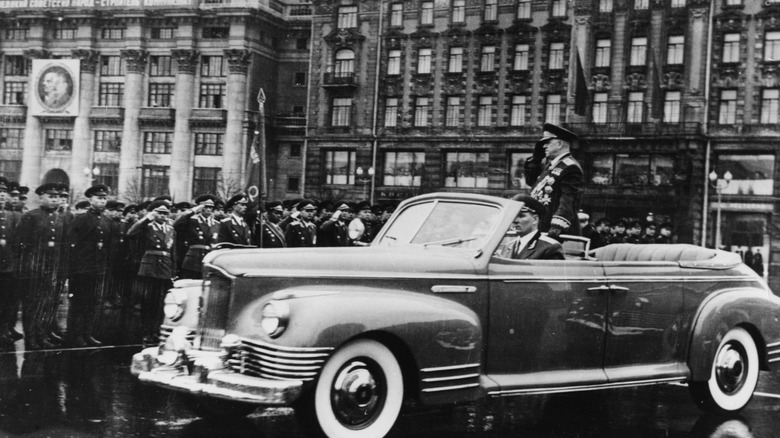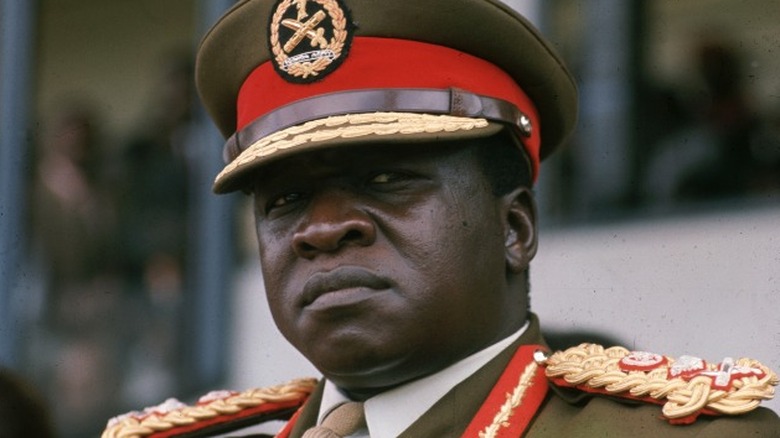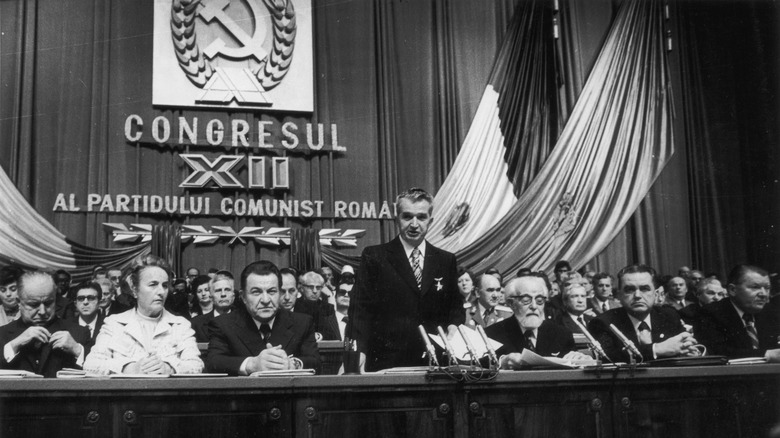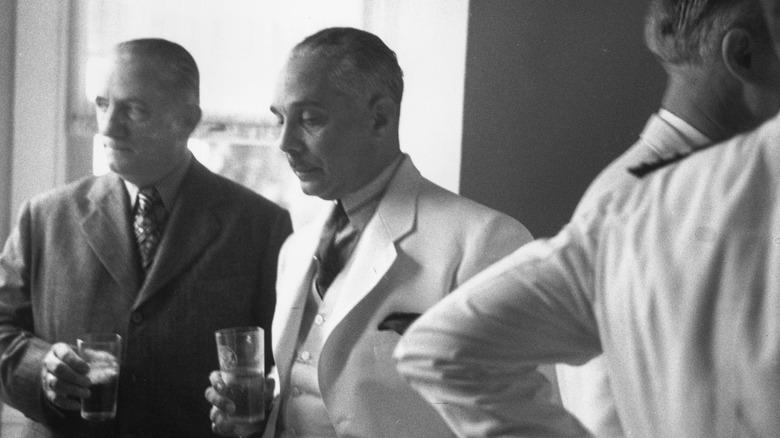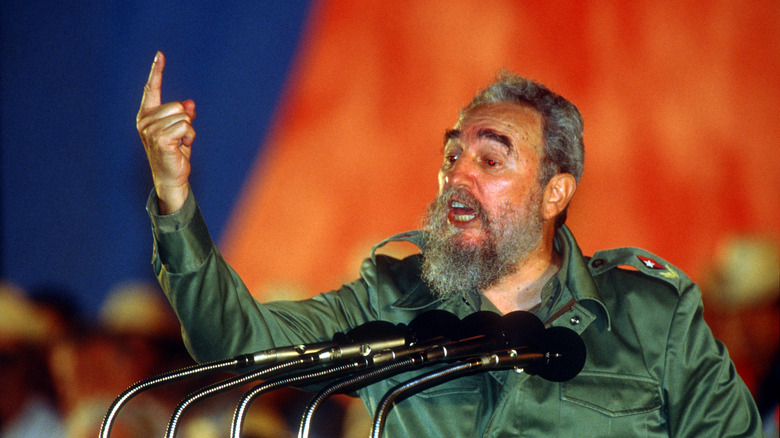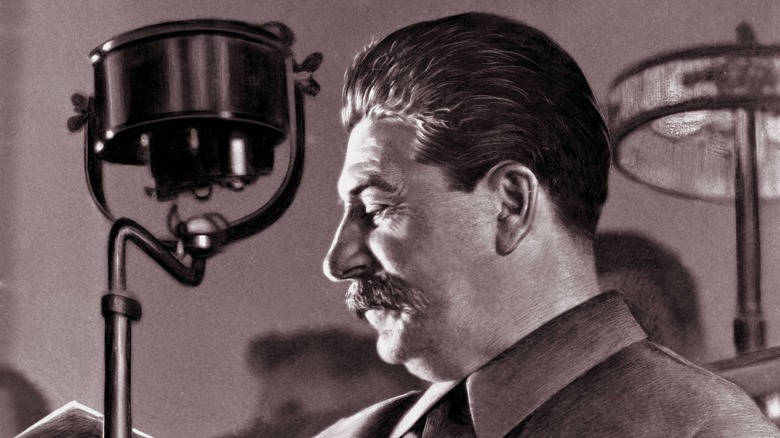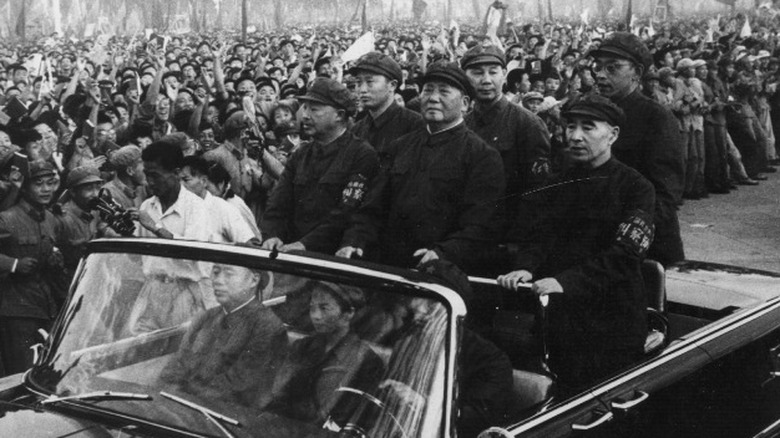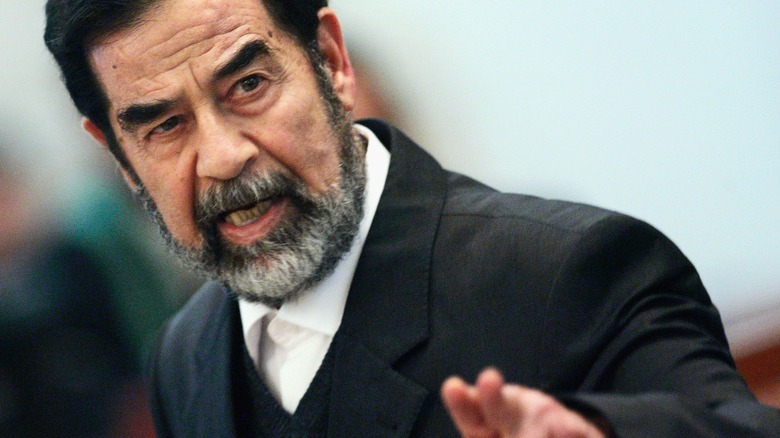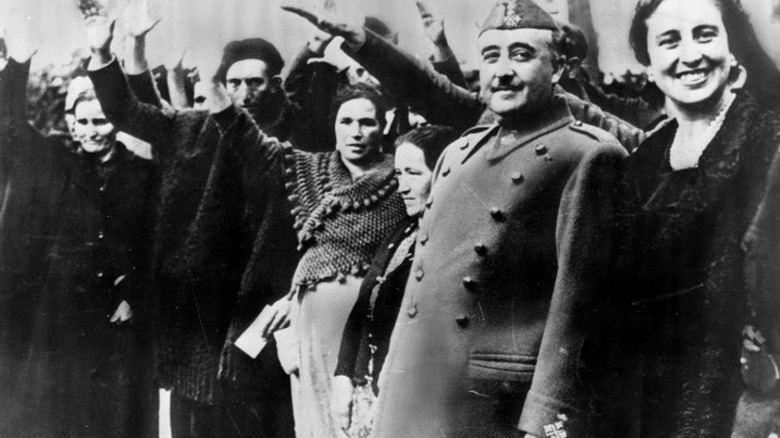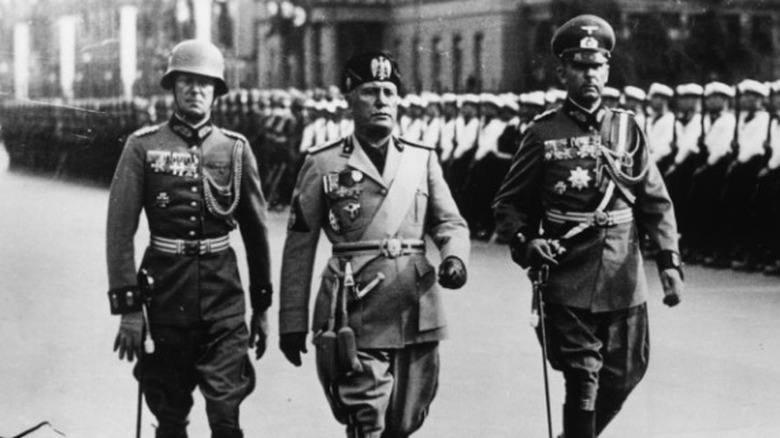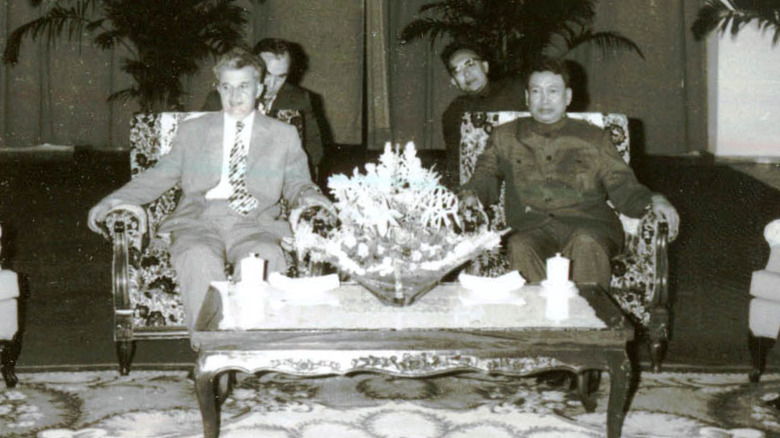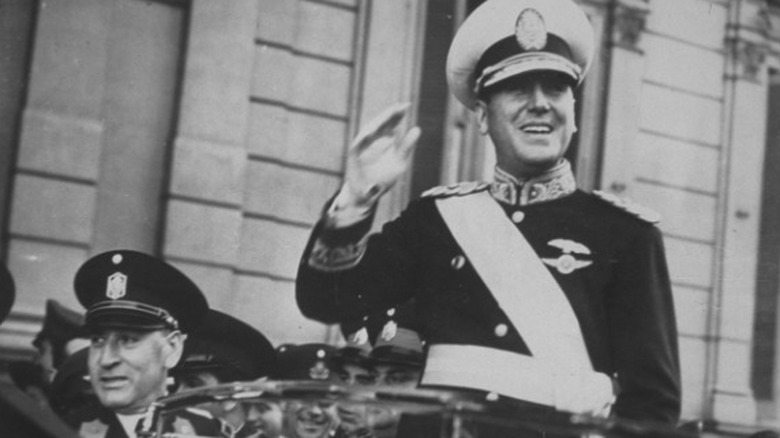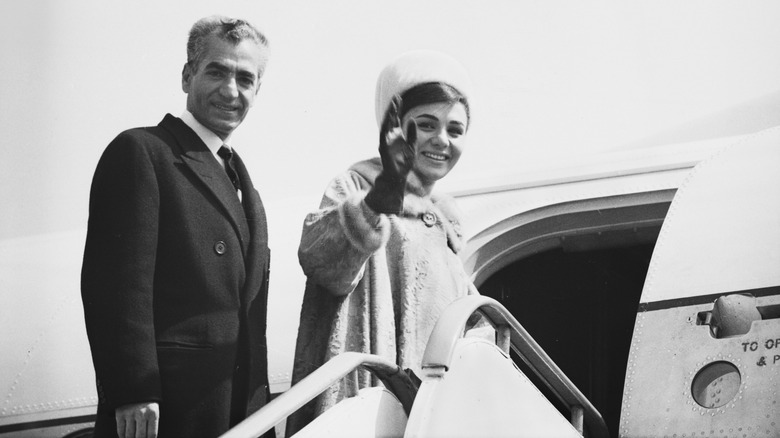Here Is What Happened To These Infamous Dictators' Cars
Dictators are feared and loathed not only by their subjects, but also by outside observers the world over. Infamous leaders such as these arouse intrigue in so many people that we often cannot stop studying their time in power. While the most brutal and violent men on the planet deserve no praise, the urge to explore their lives, philosophies, and the effects of their rule is undeniable. Millions of people suffered and perished during their periods of power, although in many of these countries, there was prosperity for some part of the population. Like anything we can study, there is nuance and shades of gray that proliferate among the world's autocrats.
One constant among autocratic dictators is the pilfering of state coffers for their personal enrichment. A common asset acquired by these leaders is automobiles. Some of them amassed impressive collections of luxury and sports cars, and all of them have used luxury limousines for official travel. While some of these limos may have been official state vehicles, the line between state and personal assets is generally pretty fuzzy. To take a look at this single facet of the lives of the world's dictators, we present what happened to these 12 autocrats' cars.
Idi Amin Dada (Uganda)
Less than a decade after gaining independence from the United Kingdom, Uganda found itself under the totalitarian rule of its army's top general, Idi Amin Dada. His eight years in office were marked with oppressive rule by means of secret police, political assassinations, and general mismanagement of the economy. Most decisions made by Idi Amin were driven by his desire to remain in power. This is particularly true of his policy to expel all residents of Asian descent, when tens of thousands of immigrants were forced out of Uganda, leaving behind a country ill-prepared to run its own economy (via History).
Like any other self-respecting dictator, Idi Amin traveled in a luxury limousine, a Mercedes-Benz 600 Pullman. The 600 set the standard for luxury when it was introduced in the '60s. Furthermore, it was the first Mercedes V8 in a production vehicle. The 600 was also a car ahead of its time with a complex hydraulic system that operated the suspension, brakes, power locks, windows, and even the trunk lid (via Heacock Classics).
The 600 was an impressive car not just for its time, but it remains so today. It is also an imposing vehicle, as anyone who shows up in a Pullman exudes a sense of wealth and power, just like an African dictator would. Idi Amin's 600 is now resting in a museum in Kampala, the capital of Uganda (via AutoJosh).
Nicolae Ceausescu (Romania)
Nicolae Ceausescu ruled Romania for more than two decades until the late '80s. During his tenure, the population suffered shortages and economic stagnation while he and his wife, Elena, built a strong cult of personality and lived lavishly while the people suffered. As part of his grandiose plans, he built a new building for the government called the Palace of the Parliament. It is such a huge building, and took so many resources to build, that it nearly bankrupt the country.
The Ceausescus did not get to enjoy their freshly-built palace for long. A groundswell of activism against the regime rejected his rule, even becoming vocal while a crowd gathered to hear him speak one day in Bucharest. Just one day later, Ceausescu was tried and executed for embezzling state funds, destruction of public property, and genocide (via Sky History).
While the Ceausescus likely had many cars, one we know of has a particularly unique provenance. As dictators are wont to do, he was gifted a car by another tyrant. Reza Pahlavi, Shah of Iran, gave Ceausescu one of his domestically-built Paykan Hillman Hunter limousines. It is not a particularly attractive car, and probably not well-built, but for Iran, it was the pride of their industrial output. Not a lot of information remains about the car, but it sold for a remarkable €95,000 in 2021, according to Radio Free Europe.
Rafael Trujillo (Dominican Republic)
Lesser known, but no less insidious, is the former ruler of the Dominican Republic, Rafael Trujillo. From the period between the World Wars through 1957, the Dominican Republic was led by a tyrant whose policies against his opposition led to the murder of anyone and everyone who dared oppose him. He held a unique grip on power by adhering to constitutional rules for presidential elections, often ruling as a shadow president behind elected puppets, winning by a lack of candidates or fair elections (via ThoughtCo).
Like many dictators, the economy did well under Trujillo. However, a good economy alone cannot pacify a populace fed up with corruption and oppression. Therefore, in 1961, with the alleged backing of the CIA, a group of assassins assembled to take out the hated ruler as he was chauffeured to his mistress in a blue 1958 Chevrolet Bel Air (via Motor Junkie). There does not appear to be much information as to its current whereabouts, but, should one come across it, they will find an aging piece of American iron riddled with bullet holes.
The last hour of Rafael Trujillo's life was spent fighting off a flurry of bullets. Given the extreme hatred of this tyrant, it is likely nobody cared to preserve the car.
Fidel Castro (Cuba)
Just 90 miles from the tip of Florida lies the closest communism has ever reached American shores. The island nation of Cuba threw out the American-backed dictator Fulgencio Batista, only to replace him with another tyrant: Fidel Castro. With the installation of a new socialist regime came the end of trade with the United States, and a new reliance on the Soviet Union for all manner of consumer goods, including automobiles (via Britannica). However, with some citizens being more equal than others, Castro and his top officials enjoyed the luxury of Russian limousines, such as the Chaika by GAZ.
The Soviet Chaika by GAZ is analogous to the Cadillac or Mercedes-Benz of the period, but was only available to the privileged few in the top ranks of the government and the KGB. The interior has the odd disposition of appearing simultaneously luxurious and spartan. It is large and covered in plush fabrics, but features few amenities. It's propelled by a fairly large 5.5-liter V8 good for 220 horsepower, which is comparable to Western cars of the time (via Hooniverse).
The final chapter of Castro's limo is perhaps the most interesting. What once moved El Jefe around Havana now serves as a taxi. A writer from Autoweek had the opportunity to ride in the Chaika, and reported that it was a plush and comfortable ride, but that it had its V8 removed and replaced with a Mercedes diesel engine. It definitely showed some wear, but remains an interesting part of history, even if its former owner was a loathsome character.
Joseph Stalin (Soviet Union)
Although Stalin was praised for his efforts with the Allies to defeat Hitler, the rest of his career is more ignominious. He starved the people of Ukraine, and sent countless political foes to labor camps in Siberia (via Britannica and PBS). He kickstarted his country's industrial capacity on the backs of the workers, and nurtured a cult of personality, including renaming the city of Volgograd to Stalingrad. He was not a good person. But, he did like good American cars.
Before the split of ideologies turned into the Cold War, American auto manufacturer Packard sent 10 cars across the Atlantic to the pre-war Soviet Union, purchased by Stalin (per Auto Restorer). One such vehicle was a 1937 Packard Super 12, powered by a V12 as the name suggests. An elaborate, decadent, and luxurious car for its time, it is an appropriate car for heads of state, even those states where everyone is "equal."
The Packard Super 12 eventually made it back to the United States, where it ended up resting at a museum in Illinois. According to ABC Chicago, this car had been reported stolen from a museum in Bulgaria in 1992. The car was given to the prime minister of Bulgaria by Stalin and by 2013, Bulgaria wanted the car back, invoking a treaty to demand its return. It may still reside in Illinois, as no more information about it seems to be readily available.
Mao Zedong (China)
While China builds more cars than any country in the world, that is only a recent development. For much of the communist era, industrial output lagged behind not only the West, but the Soviet Union and other communist states. The leader of China, Mao Zedong, or Chairman Mao, led many programs to advance the country with mostly universal failure. From the period of the Great Leap Forward to the Cultural Revolution, China remained a mostly agrarian society with modest industrial capability. Leaders of most underdeveloped nations would rely on foreign markets for machinery such as automobiles, but not Chairman Mao. He insisted on a domestic car for his official travel. The car he got was the Hongqi, or Red Flag in Chinese.
China's first automaker, FAW, delivered the first Chinese luxury automobile in 1959. The Hongqi is a large, six-seat limousine powered by a V8 engine and equipped with air conditioning, power steering, and automatic transmission. By all accounts, it is a nice-looking car with a well-appointed interior, suitable for heads of state (via Blackhawk Collection). China continued to hand-build the car up through the '80s, with a retro-inspired version returning in 2013, according to Quartz. Before the opening up of the Chinese economy by Deng Xiaoping, only the most privileged few ever rode in such a car. Today, many are in private hands, and one of the cars Mao himself rode in is in the Hongqi Factory Museum (via CarNewsChina.com).
Saddam Hussein (Iraq)
Saddam Hussein was well known for having built a vast fortune from the proceeds of Iraqi oil. He should also be among the most recognized of the despots, as it was famously the country of Iraq that the U.S. military invaded in 2003. Hussein's Baath party came to power in a coup in 1963, paving the way for him to rise up to take the top rank. He held that post from 1973 to 2003 when he was found hiding from U.S. forces in a ditch. Among the many things he was tried, convicted, and executed for was the pillaging of the state treasury (via ThoughtCo). While he lived lavishly with many palaces and cars, his son, Uday, amassed a huge stable of fine automobiles.
Ten years prior to the U.S. invasion, Saddam became incensed with Uday for acts of perceived disloyalty, and culled the younger Hussein's auto collection by burning some 50 high-dollar autos (via Car and Driver). However, the careless Uday continued to build his collection for another decade before his capture. The collection is said to have consisted of around 1,300 cars spread throughout the country, consisting of Bentleys, Astons, Bugattis, and at least one McLaren F1. Fearful of mass looting and violence, American soldiers were ordered to destroy the collections of the family, destroying many desirable and pricey automobiles. At least one special vehicle was spared, a 1935 Mercedes 500K roadster, one of two in the world and one of the most expensive Mercedes models ever. It was originally owned by King Ghazi of Iraq, and was restored by the Blackhawk Collection.
Francisco Franco (Spain)
While Spain enjoys a thriving modern liberal democracy today, the country was ruled by the authoritarian Franciso Franco for decades from the end of the Spanish Civil War in the '30s until his death in 1975 (via History). While Spain was officially neutral in WWII, Franco held sympathies with Hitler and his regime, and would often cooperate with the Nazis and offer material support. To counter the fascist leader from too much collusion with his fellow fascists, Britain and the United States used shipments of oil to restrain Franco successfully, preventing the Axis powers from drawing in another full ally because Spain had no other source of oil (via NBER). However, this would not stop him from oppressing the Spanish people and operating secret police and political murders for decades after the war.
After the war, as Europe was rebuilding, Franco placed orders for three new armored Rolls Royce vehicles; two limousines, and a convertible (via Motorpoint.com). The Rolls Royce Phantom IV is among the most exclusive car ever made, as it was only offered to heads of state, and only a total of 18 were ever built. The cars that Franco rode in were actually the property of the Spanish military, and they retain them to this day, being used to transport the current royal family.
Benito Mussolini (Italy)
Italy has a long and proud tradition of auto manufacturing, and today it produces some of the most expensive and desirable cars in the world. It should come as no surprise that a brash, young leader espousing a new nationalist ideology he called fascism wanted to be seen in an Italian car. The fascism of Mussolini's Italy merged government and corporate power with a significant emphasis on the ethnic and cultural identity of the nation, all while executing plans through a strong, centralized government. TIME explains that Mussolini thought democracy was a failed system, and that liberty and free expression were detrimental to the state. This would become central to his leadership up until he was shot by his own soldiers and subsequently hung upside down in the public square for citizens to defile (via History).
Il Duce, as he became known, often rode in a grand Alfa Romeo, Italy's sporting luxury carmaker. His was a special ordered 6C 2300B, and he used it to tour cities, greeting fawning crowds, often accompanied by Adolf Hitler. Mussolini's 6C, of which seven were built, was most unusual because the regular production 6C is a sports car, and his was coach built as an open-top car with a large rear seat from which he could stand to address the people. 6C Alfas came with straight-six inline engines fed by dual weber carburetors good for 105 horsepower. The car was sold by the government in 1945 and ended up hidden behind a wall of a garage to avoid being taken by the Americans as war spoils. It eventually came out of hiding, and last went up for auction in 2014 (via Military Trader).
Pol Pot (Cambodia)
The Vietnam War era was a turbulent and violent time that saw atrocities play out throughout Southeast Asia. Governments were in flux, and the divide between communist and capitalist systems was sharp. Among the worst leaders of the time was Pol Pot of Cambodia, who would lead what became known as the Khmer Rouge, officially the Communist Party of Kampuchea. Sadly, the man who led this country attempted to find solutions to the state's problems, real and perceived, by ill-thought programs of social engineering with little to no practical discussion of possible outcomes. As such, millions of Cambodians were sent from the cities to die at the hands of the military apparatus that acted as Pol Pot's personal henchmen, tasked with carrying out extrajudicial murders for numerous ideologically-driven reasons (via BBC). The list of crimes committed by Pol Pot's regime could fill volumes.
The strictly Marxist leader, committed to his twisted brand of socialism, rode in a Mercedes. Unlike his starving and tortured population, Pol Pot enjoyed the luxury of riding in one of many stretched German sedans. According to Spiegel International, a British banker discovered the car in 2001 as it was being used to deliver melons to the central market. He bought the car and had it restored to like-new condition, taking it for occasional Sunday drives. He put the car up for auction on eBay with an opening bid of £35,000 in 2007. Spiegel notes some claims casting doubt on the car's provenance, but it was well known that Pol Pot had several Mercedes with which to carry out his horrible plans.
Juan Peron (Argentina)
The legacy of Juan Peron in Argentina is complex and complicated, and has had lasting effects up to the current day. His presidency saw relatively good times for the country, but as it wore on, the stifling of free speech, and the elimination of opposition throughout the government, contributed to a fall from grace. His wife, Eva Duarte, contributed to his political life directly, almost as if she was also in power herself. She was also adored by the poor, or descamisados, as she called them. However, after her death in 1952, Peron's popularity plummeted until he was exiled from the country following a military coup in 1955 (via Biography).
Peron's political life was difficult, to sum up in a few words, but his private life was filled with luxury. He and Eva spent obscene amounts of the country's wealth on themselves, buying designer clothes and treating their friends to lavish banquets. According to Paul Fraser Collectibles, he bought a Ferrari 212 Inter Coupe at the 1952 Paris Motor Show. Aware of how it would look to bring home a new Ferrari amidst a declining economy, he persuaded Ferrari to change the chassis number to appear like an older model. After he was ousted, the government took control of his possessions and displayed them to the public. The beautiful early Ferrari ended up in private hands, last going up for auction in 2018 at Sotheby's, where it sold for a tidy $1.2 million.
Shah Mohammed Reza Pahlavi (Iran)
The country of Iran was once ruled by an autocrat with a feared secret police force who had come to power with the help of the CIA: Shah Mohammed Reza Pahlavi. According to NPR, in 1953, Prime Minister Mohammad Mossadegh was overthrown in a coup lasting only four days. The popular and much-loved prime minister had promised to eject the British company controlling Iran's oil in order to keep its wealth for the benefit of the citizens of Iran. The CIA admitted its role in 2013. The installation of the Shah led to the 1979 revolution in which the current hard-line government took power.
One of the perks of being a Shah, which is Farsi for king, is having companies cater to your extraordinary whims. As such, Maserati was all too happy to accommodate the Shah by building him the 5000 GT 2+2 grand touring car. Featuring the signature Maserati trident prominently in the grill, and supple leather through the interior, this car is an example of the finest work ever from Maserati. The manufacturer keeps a record of the car on its official website as a testament to its fine build quality and placement in the hierarchy of classic Maseratis.
Details about his specific 5000 GT are scarce, but a similar car in a shocking state of disrepair sold for half a million dollars at Sotheby's in 2019. Should it emerge for sale any time soon, it will surely reach astronomical price levels, as it was the Shah's car that began Maserati's efforts to build one of the most exclusive cars in its history.
